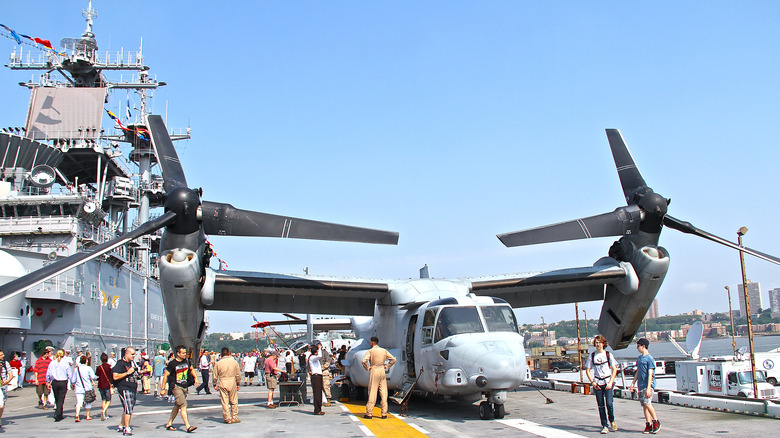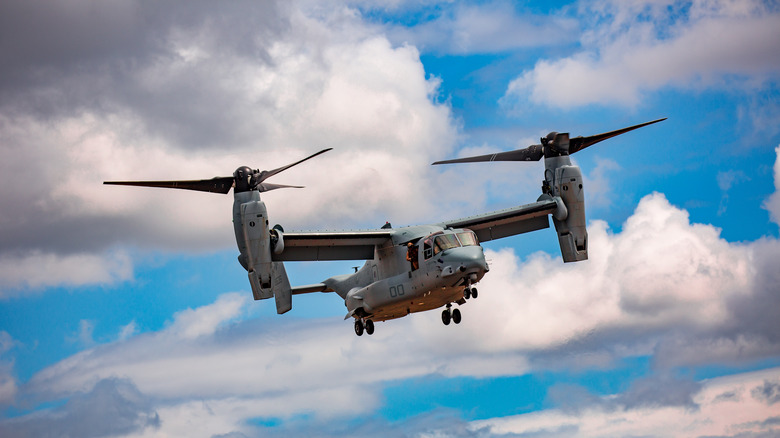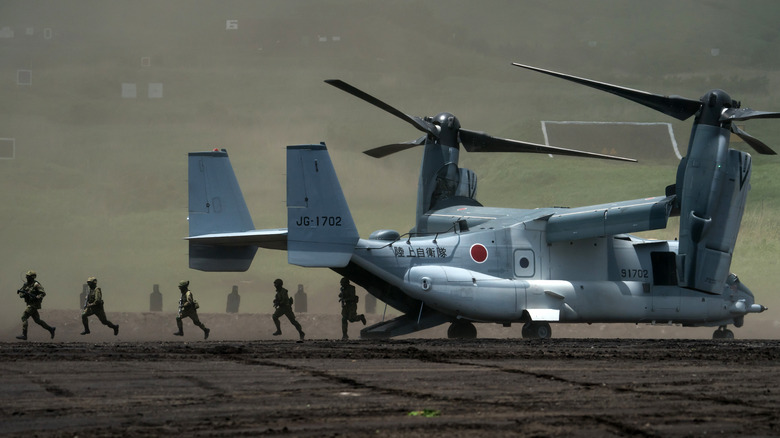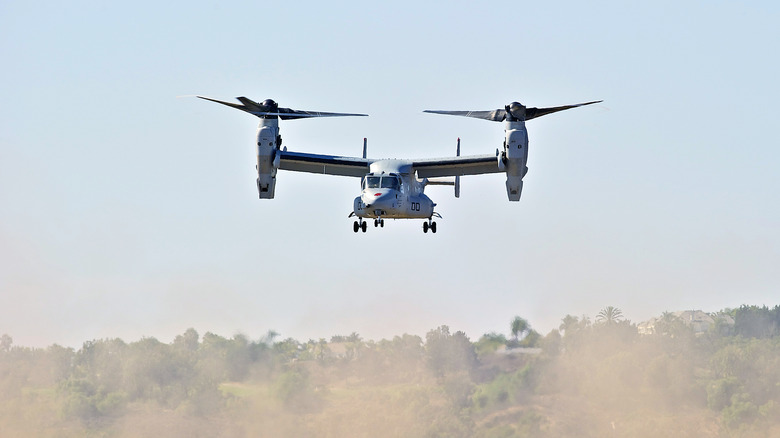Bell Boeing V-22 Osprey: How Much Do They Cost, And What Are They Used For?
Ever look up into the sky and see an aircraft that looks like a cross between a helicopter and an airplane? If you have, there's a good chance it was the V-22 Osprey, a vertical takeoff and landing (VTOL) vehicle that is used for a variety of applications by the United States military. By spinning the propellers on either side of the fuselage, the Osprey can lift straight up, as well as land vertically, just as a helicopter does. Once it's in the air, its propellers can change orientation, allowing it to fly like an airplane — this type of hybrid vehicle is called a tiltrotor aircraft. The innovative technology allows it to gain access to and be used from more areas without needing a runway, while also achieving the faster speeds and longer range that airplanes typically have over helicopters.
The Osprey is made through a partnership between Bell Helicopter and Boeing. According to the official website of the United States Marine Corps, the replacement cost of a V-22 Osprey is $71.3 million. So when you do see one in the sky, you're seeing tens of millions of dollars fly overhead. With 76 of the MV-22 procured by the U.S.M.C. and over 400 total V-22s having been manufactured to date, that equates to billions of dollars spent on the Osprey aircraft alone.
The Osprey will be the go-to medium-lift aircraft for the military
The Osprey can operate with a four-person crew (two pilots and two flight engineers) and is designed for combat, combat support, combat service support, and Special Operations missions. Its primary use is for amphibious transport of troops, equipment, and supplies from assault ships and land bases. The CV-22 is employed by the Air Force and U.S. Special Operations Command for Spec Ops, while the Navy uses the HV-22 for Combat Search and Rescue and fleet logistics support. The Marines, meanwhile, are replacing the Corps' aging fleet of CH-46E Sea Knight and CH-53D Sea Stallion medium-lift helicopters with the Osprey. The MV-22 will be transitioned to all Marine Corps medium-lift active duty and reserve tactical squadrons, the medium-lift training squadron (FRS), and the executive support squadron (HMX).
The Osprey has been deployed around the globe for a range of missions, including combat operations, humanitarian efforts, peacekeeping, and regional stability initiatives. Some conflict zones where the Osprey has been put to use include Afghanistan, Iraq, Syria, Libya, and parts of Africa, as well as the Asia-Pacific region, where it's been a part of military exercises, among other uses. The Osprey typically operates in fixed-wing mode for most of its missions, which reduces wear and tear, as well as operation costs. It will also fly at a higher altitude than helicopters usually do in order for its crew to have longer line-of-sight communications and stronger command and control during missions.
The Osprey's been around longer than you might imagine
The military first started using the Osprey in an official capacity in 2007, which is why it still feels like a relatively modern type of aircraft. Its first flight, however, was in 1989. After the disastrous Operation Eagle Claw in 1980 — the failed mission to rescue American hostages from Iran — the U.S. military made it a priority to develop a military transport that could quickly take off and land vertically. In 1981, the Department of Defense created the Joint-service Vertical Take-off/Landing Experimental (JVX) program, which was initially run by the Army.
Bell Boeing was awarded the development contract in 1983 for the V-22, and it was another six years before the Osprey began its first test flights. The unprecedented and complicated technology of tiltrotor avionics meant there were plenty of design alterations and bugs to work out, which is why it took so long for the Osprey to finally fly its first mission. While the initial budget in 1988 to develop the V-22 was $2.5 billion, by 2008 it exceeded tens of billions of dollars. Between ballooning costs and headline-making accidents, the Osprey has had its fair share of critics over its lifespan.
The Osprey has impressive specifications
When its wings are spread, the Osprey is 57 feet 4 inches long, 84 feet 7 inches wide, and 22 feet 7 inches tall. When they're folded, it has a longer but slimmer profile: 63 feet long, 18 feet 5 inches wide, and just 8 feet 3 inches tall. While the Osprey is something of a hybrid between a helicopter and a fixed-wing airplane, it isn't really either — it's definitely its own thing. The rotors of the V-22 are folded when the vehicle isn't in use, to make it more efficient for storage. Because of this, its diameter is five feet less than what would be considered optimal for similarly-sized aircraft that engage in vertical takeoff.
It takes 90 seconds for the rotors to fold and for the Osprey's wing to rotate and align front-to-back with the fuselage. Because exhaust heat from its engines are capable of damaging the flight decks of aircraft carriers and other landing zones, specially-designed portable heat shields are usually placed underneath an Osprey. This has been a practice for years while the military figures out how to redesign and strengthen flight decks as a longer-term solution.
The MV-22 can support 24 seated combat troops and, powered by dual Rolls-Royce AE1107C engines that each produce 6,150 shaft horsepower, has a cruise airspeed of 240 knots. It's also capable of aerial refueling, and has an amphibious pre-assault raid mission range of 200 nautical miles, as well as a self-deployment range of 2,100 nautical miles. This range and versatility is a big part of why so much money has been spent on developing and manufacturing the Osprey, and why it continues to be used by the Marine Corps and other armed forces.



